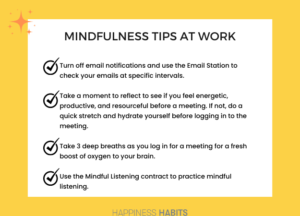In the fast-paced world of urban professionals, where stress and distractions seem to be the norm, finding moments of peace and clarity can make a significant difference. That’s where mindfulness comes in. But incorporating mindfulness into a busy schedule may seem challenging. Fortunately, there’s a solution – mindfulness micro-practices.
In this article, we’ll explore how small changes can have a big impact on your well-being, and how you can incorporate mindfulness micro-practices into your daily life.
Why Should You Be Mindful?
Mindfulness has numerous benefits, especially for urban professionals. It improves happiness, engagement, and overall quality of life. By reducing stress and anxiety, mindfulness allows you to be more resilient, make better decisions, and spark creativity. It enhances communication, improves interpersonal relations, and cultivates empathy, leading to stronger relationships within and outside of the workplace.
What Keeps Us from Being Mindful?
Before delving into mindfulness micro-practices, it’s essential to understand what prevents us from being mindful. Internal thoughts, distractions, emotional disturbances, lack of attention, and judgment are common obstacles. Our minds often wander, losing touch with the present moment and becoming engrossed in obsessive thoughts or worries about the past and future. External distractions, such as technology and a constantly stimulated environment, can also hinder our ability to be fully present. Additionally, emotional disturbances and judgments, both self-inflicted and toward others, create barriers to mindfulness.

How Can We Be Mindful?
Now that we recognize the challenges, it’s time to explore how we can overcome them and cultivate mindfulness through micro-practices. These small yet powerful techniques can be seamlessly integrated into our daily routines, making mindfulness a natural part of our lives.
Mindfulness Technique #1 – Reduce the Overwhelm Caused by Internal Thoughts:
One effective micro-practice is the use of capture tools, where you jot down your thoughts and empty your mind, relieving the burden of mental clutter. Meditation, mindfulness cups, breathwork, and focused breathing exercises are also valuable tools to calm the mind and cultivate present-moment awareness. By giving ourselves permission to let go of racing thoughts and simply be present, we can reduce stress and create a greater sense of inner calm.
Mindfulness Technique #2 – Manage Distractions by Reducing Inputs/Stimulants:
To counter external distractions, inventory all the inputs in your life and consciously reduce them. Mute unnecessary notifications, limit consumption of 24/7 news, and declutter your physical and digital spaces. By creating an environment that minimizes distractions, you can enhance your focus and be more present in your tasks. Designate specific times for checking emails or using social media, and resist the urge to multitask. This intentional approach to managing external stimuli can lead to increased productivity and a greater sense of clarity.
Mindfulness Technique #3 – Overcome Emotional Derailers:
Emotional mastery is key to maintaining mindfulness. Mindfulness cups, breathwork, and techniques like pausing before responding can help you gain control over emotional triggers. By taking a moment to reflect on your emotions and respond rather than react, you can cultivate a sense of inner balance. Engaging in self-reflection and considering alternative perspectives can also foster a non-judgmental approach, allowing you to navigate challenging situations with empathy and understanding.
Mindfulness Technique #4 – Improving Attention by Being Fully Engaged:
Being wholly immersed in daily activities can work wonders in fostering mindfulness. Integrate all your senses with intent, such as during morning routines or mealtimes.
Morning Rituals: Do you take time to feel the warmth of the morning sunlight and breathe in the fresh air?
Mealtime Practices: Do you savor every bite with awareness and pay attention to the textures and flavors? Tried eating with your non-dominant hand!
Attentive Listening: Do you listen to conversations with undivided attention, listening to understand, not just physically being there?
Engaging all your senses allows you to fully experience and appreciate each moment, enhancing your overall sense of well-being.
Mindfulness Technique #5 – Practice Being Non-Judgmental:
Adopting a non-judgmental mindset is crucial for mindfulness. Slow down the speed of your conclusions, observe situations objectively, and look for alternate causes of behavior. Practices like gratitude, acceptance, and compassion can help foster a non-judgmental approach, allowing you to experience the world with greater openness and empathy. By letting go of preconceived judgments, you create space for greater understanding and connection with yourself and others.

Incorporating mindfulness micro-practices into your daily life as an urban professional can have a profound impact on your well-being.
By taking small steps to reduce internal overwhelm, manage distractions, overcome emotional derailers, improve attention, and embrace non-judgment, you can enhance your overall mindfulness.
These practices don’t require large time commitments but can be seamlessly integrated into your existing routines. Embrace the power of small changes and discover the big impact they can have on your happiness, resilience, focus, and relationships.
Start your mindfulness journey today and witness the transformative effects it can bring to your life as an urban professional.